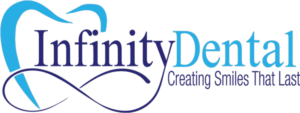An oral exam is routinely performed by the dentist during the course of an initial comprehensive exam and regular check-ups. An oral cancer exam refers to the identification and management of diseases pertaining to the maxillofacial and oral regions.
The soft tissue of the mouth is normally lined with mucosa, which is special type of skin that should appear smooth in texture and pink in color. Any alteration of the color or texture of the mucosa may signal the beginning of a pathologic process. These changes may occur on the face, neck, and areas of the mouth (e.g., gums, tongue, lips, etc.). The most serious of these pathologic changes (which may or may not be painful) is oral cancer, but there are also many other common pathologic problems.
Geographic Tongue – Also known as Benign Migratory Glossitis or Erythema Migrans, is a condition where the tongue is missing papillae (small bumps) in different areas, and a map-like appearance can develop. This condition is usually seen as red well defined areas on or around the sides of the tongue. The red patches (which can look like an unsightly rash) may come and go from hours to months at a time and cause increased sensitivity to certain substances.
Median Palatal Cyst – This cyst is of developmental origin and is essentially a fluid filled skin sac. It usually appears in the middle of the palate and may cause substantial discomfort.
Hairy Tongue – An overgrowth of bacteria or a yeast infection in the mouth which can cause the tongue to appear hairy and black. This condition is usually a result of poor oral hygiene, chronic or extensive use of antibiotics, or radiation treatments to the head or neck. It is often also seen in HIV positive patients and those who are intravenous drug users. Hairy Tongue may or may not require treatment.
Treatment of Pathological Diseases
In the majority of cases, the pathological changes experienced in the oral region are uncomfortable and disfiguring, but not life threatening. However, oral cancer is on the rise (especially among men) and the chances of survival are around 80% if an immediate diagnosis is made.
Oral cancer is a general term used when referring to any type of cancer affecting the tongue, jaw, and lower cheek area. Since it is impossible for the dentist to decisively diagnose a pathological disease without taking a biopsy sample of the affected area, seeking immediate treatment when changes are first noticed might be a life and death decision. For less serious problems, there are several options available, such as:
-
Antibiotics – In the case of a bacterial infection or persistent soreness, the dentist may prescribe a dose of antibiotics to return the mucosa to its natural state. This will alleviate soreness and discomfort.
-
Diluted Hydrogen Peroxide – When poor oral hygiene is causing changes to the soft tissue, the dentist may prescribe a diluted hydrogen peroxide mouthwash. This will kill more bacteria than regular mouthwash and improve halitosis (bad breath).
-
Oral Surgery – If the patient has cysts or abnormal non-cancerous growths, the dentist may decide to completely remove them. This can improve comfort levels, alleviate breathing problems, and make speech substantially easier depending on the location of the cyst.
Oral Examinations
During the course of a regular check up, the dentist will thoroughly inspect the soft tissue of the mouth and take serious note of any changes. If there are cell changes present, the dentist will take a biopsy of the affected area and send it away to be analyzed by laboratory specialists. When definitive results are obtained, the dentist can decide on the best course of treatment.
Oral Cancer Screenings
An oral cancer screening is usually performed during a comprehensive or recall (check-up) exam. Screening is painless and only takes a few minutes. The dentist or hygienist will use a laser light to assess the soft tissue for cell changes that might be indicative of oral cancer. If such cell changes are present, a small biopsy will be taken and sent to a laboratory for review. If the biopsy indicates that oral cancer is present, an excision (removal) will generally be performed.
If you are experiencing any pain or symptoms that cause you concern, we encourage you to contact us today to schedule an appointment.



The hygienist did an excellent job on my teeth